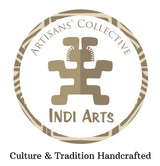We do not pretend to know thoroughly the history of the Gunadale (better known as Kuna people) nor of their artwork: Molas. Like many indigenous groups around the world, they have their own history, stories and beliefs that outsiders to this culture can only comprehend to a certain extend. Nevertheless, to the best of our knowledge we want to try introducing the significance and history of Molas while trying to explain the meaning of the Mola designs that decorate our products.
Molas’ History
“Molas have been among the Kunas since the beginning of time. According to their belief, their designs and the technique to make them were kept in the Galus, sacred places that exist in the different layers of the universe. Many Neles, (spiritual leaders of the Kunas) tried to travel to the Galus, but the scissors specialists, very beautiful women who protected them, did not allow them to enter”
“Only Nagegiryai, a woman Nele could enter. She first traveled to the galbiSabbiMolanalamaggale Galus where she saw numerous changing designs. She went and came back many times to see the painting on the trees and other changing designs at the Galus. On another trip, she arrived at the Galub Dugbis where she learned the writing of the Molas. Sitting on her hammock and combing her smooth long hair, Nagegiryai taught with her songs this writing and art to the Kuna women.” – Museo del Oro- Banco de la Republica, Bogota, Colombia.
Molas’ Meaning & Inspiration
There are two main categories for the designs of Molas:
- Molas Naga- their designs are purely abstract and give a geometrical shape to the elements of nature
- Molas goaniggadi- these designs portrait Kuna women daily lives and their surrounding environment.
Molas Goaniggadi is the type of Mola we can recognize the most. Talking to the Kuna women in San Blas Island in Panama who make Molas Goaniggadi, they say that they use the environment around them and sometimes also their dreams as inspiration for creating their Molas designs.
In the Gunadule (Kuna) view of the cosmos Molas Naga, consist of thirteen designs or texts arranged in the form of a large shield. The thirteen designs represent elements of nature including minerals, reeds, animals and palms. The Mola Naga is considerate as source of fertility, it is believed that this Mola protects Kuna women from any danger that could threatens them, including diseases and evil spirits. When a Kuna woman carries the Mola in her blouse, she disguises with Mother Earth, covered by trees, flowers, leaves and soils.
In the protection Molas, you can find four styles of drawing: arrows inwards and outwards, connected spirals, diagonal curves and independent modules.
The Molas in Our Products
Our products use protection Molas as decoration and as we explained before, each protection Mola has its own meaning and history.
For us is incredibly to see how the Kunas are able to keep a big part of their traditions alive by continue to elaborate Molas. We acknowledge the makers of our products so we can contribute increasing awareness around the world about them while helping this community and its artisans to gain recognition for their great artwork and culture. Finally, by buying their artwork we want to help to support the maintenance of this Kunas’ unique art form and culture, as Molas define and resemble very much their identity and worldview.

Photo from Carvajal, Ruth & Aguilar, Milton- 2012- Universidad de Antioquia
